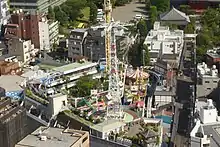Hanayashiki
Hanayashiki (浅草花やしき, Asakusa hanayashiki) is an amusement park in Asakusa, Taitō, Tokyo[4] that has operated since 1853. It is operated by Hanayashiki Co., Ltd., a subsidiary of Bandai Namco Holdings. It is claimed to be the oldest amusement park in Japan. One of the unofficial mascots of the park is the Panda Car (パンダカー).[1]
 | |
 Asakusa Hanayashiki in Asakusa, 2015 | |
| Location | Asakusa, Taitō, Tokyo, Japan |
|---|---|
| Coordinates | 35°42′55.66″N 139°47′40.84″E |
| Slogan | The oldest amusement park in Japan (日本最古の遊園地, Nihon saiko no yuenchi)[1] |
| Owner | Bandai Namco Holdings |
| Operated by | Hanayashiki Co., Ltd |
| General manager | Akihiko Hirota[2] |
| Opened |
|
| Previous names |
|
| Operating season | Year-round |
| Area | 5,800 square metres (1.4 acres)[3] |
| Website | Official website |
| Status | Operating |
History
Origins
Asakusa Hanayashiki which opened in 1853, at the end of the Edo period (1603-1867), is considered by many people as the oldest amusement park in Japan. In fact, the definition of an amusement park was unclear at that time. During the first two decades since the park opened, it was a botanical garden created by garden designer Morita Rokusaburo, where the main attractions were tree peonies and chrysanthemum work. The place was called Hanayashiki (花屋敷), which means Flowery Mansion.
Around 1872 (the beginning of the Meiji period), an amusement facility was established inside the park. From the Taisho era to the early Showa era, it was also known as also one of the leading zoos in Japan, and produced news such as the birth of a tiger quintuplet and the birth of Japan's first baby lion.[5](p203) The Great Kanto earthquake occurred in the same year. Many of the animals were killed in the subsequent fires while locked in their cages. One famous story from that event is the head of the park pouring water on the old elephant in an unsuccessful attempt to save its life.
In 1930, “The Memorial of Birds and Animals” was erected for the animals that were burned to death because of the earthquake.[5](p203) The animals that survived were later sold to the Sendai City Zoo by 1935.[6](p42) The park was effectively closed.
In 1939-40, the park was purchased by the Suda-cho Restaurant (須田町食堂), and the name was changed to Shokudo Yuenchi Asakusa Rakutenchi (食堂遊園地浅草楽天地). However, the park was resold to the Sho-chiku (松竹), and the name became Theater Rakuten (劇場楽天地, Gekizyō Rakutenchi).[5](p204)
Hanayashiki was demolished in 1944 in accordance with Japan's Air Defense Law (1937; revised 1941) during World War II. Building removal, or structure evacuation, was a process of creating firebreaks to prevent fires from spreading during Allied air raids.
Post war
In 1947, the park rebuilt as Joint-stock company Asakusa Hanayashiki (合資会社浅草花屋敷, Gōshi Kaisha Asakusa Hanayashiki) operated under joint management by Tetsuo Amano (天野鉄男) from Sho-chiku and Teiichi Yamada (山田貞一) from Togo Gorakuki (東洋娯楽機). In 1949, Togo Gorakuki became to sole operators in 1949, and the name was changed to Asakusa Hanayashiki (浅草花やしき). Yashiki was changed from Chinese characters to Japanese characters.[5](p217)
In 1953, the roller coaster began operation, and it was named "Yomiuri Rocket Coaster". This is the oldest roller coaster that exists in Japan today. In addition, the "Bee Tower" was built in 1960. These attractions became very famous.
Before 1985 no admission fee was charged. Once inside the park, visitors would pay for each ride. However, the park was disturbed the order because anyone could enter the park. For example, the drunken person enters there and sleeping or shouting. It is not safety place. Also, young people gathered in front of a game arcade. Their profit did not increase because of these situations, so operators decided to set an admission fee from 1985.
21st century
In 2004, the operator SuitesーOligo (formerly Toyo amusement machine) bankruptcy, into the "Club Rehabilitation (Japanese : Clubs Reorganization Law)" process, and as Asakusa local businesses Bandai provide operational support group, so that it's the Cape Department of Corporation subsidiary Hanayashiki (Japanese: Corporation took ya shi ki ) (formerly known as Corporation Puaza those have Bldg su) which receives light flower Yashiki right to operate from August 31.
In September 2016, "Bee Tower" was and demolished to make room for Asakusa Hana Gekijyou (浅草花劇場), which opened in April 2019. There is a theater that provides a variety of entertainment, including productions, concerts by popular musicians, and martial arts.
In popular culture
- 1986 - To Sleep So As To Dream (夢みるように眠りたい, Yumemiru yō ni nemuritai)
- 2020 - Rent-A-Girlfriend (彼女、お借りします, Kanojo, Okarishimasu)[7]
References
- "Hanayashiki | 浅草花やしき". hanayashiki.net. Archived from the original on 11 August 2020. Retrieved 22 October 2020.
- "Kabushikigaisha Hanayashiki Dai 38 Ki Kessan Kōkoku" 株式会社花やしき 第38期決算公告 [Asakusa Hanayashi Co., Ltd. 38th Term Financial Results Announcement]. catr.jp (in Japanese). Corporate Activities Research Institute. 8 June 2020. Archived from the original on 9 June 2020. Retrieved 22 October 2020.
- Lambe, Michael (31 July 2018). "Asakusa Hanayashiki Amusement Park". asakusastation.com. Archived from the original on 22 October 2020. Retrieved 22 October 2020.
- "Asakusa Hanayashiki: Japan's oldest amusement park". appetiteforjapan.com. 28 May 2016. Archived from the original on 28 July 2020. Retrieved 22 October 2020.
- Ozawa, Emiko (1 October 2006). Edo-kko to Asakusa Hanayashiki Ganso Theme-Park Funto-no Kiseki 江戸っ子と浅草花屋敷 元祖テーマパーク奮闘の軌跡 [Edokko and Asakusa Hanayashiki: The trajectory of the original theme park struggle] (in Japanese). Shogakukan. ISBN 978-4093876322. OCLC 676137339.
- Hashizume, Shinya (20 September 2000). Nihon no Yuenchi 日本の遊園地 [Japanese Amusement Park]. Japan: Kodansha. ISBN 978-4061495203. OCLC 52654118.
- "Tomodachi no Kanojo" 友達の彼女 [Friend's Girlfriend]. Rent-A-Girlfriend. Season 1. Episode 10 (in Japanese, English, and Russian). 12 September 2020. JNN. Retrieved 20 October 2020 – via Crunchyroll.

